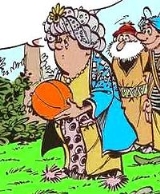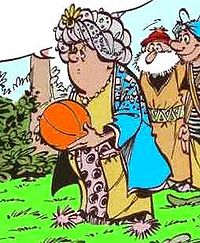
Jean Tabary
Encyclopedia
Biography

Stockholm
Stockholm is the capital and the largest city of Sweden and constitutes the most populated urban area in Scandinavia. Stockholm is the most populous city in Sweden, with a population of 851,155 in the municipality , 1.37 million in the urban area , and around 2.1 million in the metropolitan area...
and made his comics debut with Richard et Charlie published in the comics magazine
Franco-Belgian comics magazines
Belgium and France have a long tradition in comics. They have a common history for comics and magazines.In the early years of its history, magazines had a large place on the comics market and were often the only place where comics were published. Most of them were kids-targeted.In the 1970s,...
Vaillant
Pif gadget
Pif Gadget was a French comic magazine for children that ran from 1969 to 1993 and 2004 to 2009. Its audience peaked in the early 1970s.-History:Created as an outlet of the French Communist Party, it was initially entitled Le Jeune Patriote...
on November 5, 1956. For Vaillant (in 1965 renamed Pif) Tabary also drew Grabadu et Gabaliouchtou, and eventually the hit series Totoche in 1959, which produced another series with two if its characters, Corinne et Jeannot, and its own short-lived periodical Totoche Poche. Tabary continued to draw this series until 1976.
In 1962 Tabary began a long-lasting collaboration with René Goscinny
René Goscinny
René Goscinny was a French comics editor and writer, who is best known for the comic book Astérix, which he created with illustrator Albert Uderzo, and for his work on the comic series Lucky Luke with Morris and Iznogoud with Jean Tabary.-Early life:Goscinny was born in Paris in 1926, to a family...
, creating the series Les aventures du Calife Haroun el Poussah, first published in Record on January 15, 1962. Shifting its focus and title name to the evil protagonist
Protagonist
A protagonist is the main character of a literary, theatrical, cinematic, or musical narrative, around whom the events of the narrative's plot revolve and with whom the audience is intended to most identify...
/anti-hero
Anti-hero
In fiction, an antihero is generally considered to be a protagonist whose character is at least in some regards conspicuously contrary to that of the archetypal hero, and is in some instances its antithesis in which the character is generally useless at being a hero or heroine when they're...
of the series, Iznogoud
Iznogoud
Iznogoud |French]] accent) is a French comics series featuring an eponymous character, created by the comics writer René Goscinny and comics artist Jean Tabary...
became a considerable success, and was eventually adapted into a cartoon
Cartoon
A cartoon is a form of two-dimensional illustrated visual art. While the specific definition has changed over time, modern usage refers to a typically non-realistic or semi-realistic drawing or painting intended for satire, caricature, or humor, or to the artistic style of such works...
TV series. In 1968 the series changed serial publication magazine to Goscinny's Pilote
Pilote
thumb|Cover of the first Pilote teaser issue, #0.Pilote was a French comics periodical published from 1959 to 1989. Showcasing most of the major French or Belgian comics talents of its day the magazine introduced major series such as Astérix le Gaulois, Blueberry, Achille Talon, and Valérian et...
. Valentin le vagabond, another series Tabary initially created with Goscinny, also appeared in Pilote since 1962.
After Goscinny's death in 1977, Tabary continued to create Iznogoud albums. Tabary's own publishing label, at first named Editions de la Séguinière, then Éditions Tabary, continues to publish Tabary work, ultimately albums in the Corinne et Jeannot series, and the most recent Iznogoud volume, La faute de l'ancêtre in 2004.
Sources
- Tabary publications in Vaillant and Pif, Pilote and Record BDoubliées
- Tabary albums Bedetheque
Footnotes
External links
- Tabary biography on Lambiek Comiclopedia
- Éditions Tabary official site

